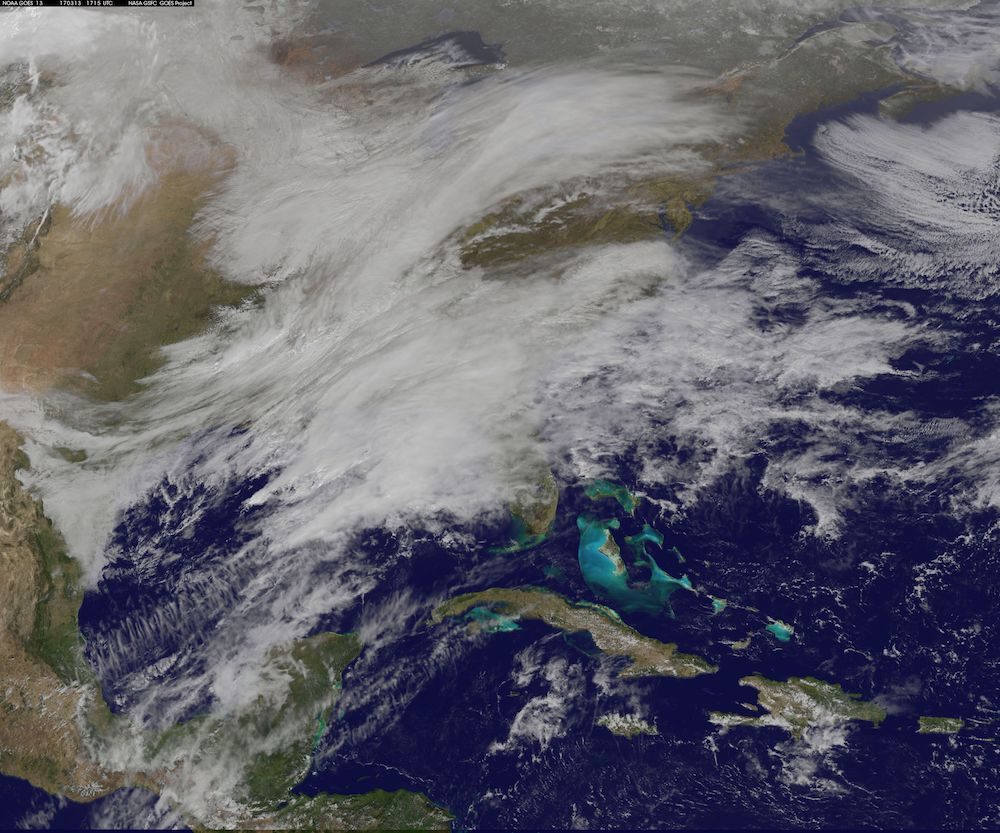SUMMARY
This is AI generated summarization, which may have errors. For context, always refer to the full article.

NEW YORK CITY, USA (3rd UPDATE) – Winter Storm Stella dumped snow and sleet Tuesday, March 14, across the northeastern United States where thousands of flights were canceled and schools closed, but appeared less severe than initially forecast.
Forecast as potentially the most powerful winter storm of the season, it had been set to dump up to two feet (60 centimeters) of snow in parts of New York and whip the area with winds of up to 60 miles per hour (95 kilometers per hour), causing treacherous whiteout conditions.
But after daybreak the National Weather Service (NWS) revised down its predicted snow accumulation for the city of New York, saying that the storm had moved across the coast.
A blizzard warning, which went into effect at midnight, was canceled for the city and replaced with an advisory for snow and sleet.
Traffic was limited in Midtown Manhattan, with a few pedestrians out walking as workers spread salt and shoveled snow in Times Square, an Agence France-Presse photographer said.
“We’re looking at four to six inches (10 to 15 centimeters) across much of New York City, maybe just over six inches for northern parts of the city, then lower amounts in Long Island,” meteorologist Joe Pollina told Agence France-Presse.
“As you head north into Westchester and northeast New Jersey up to a foot is still possible for the north,” he added.
A wintry mix would continue to fall through the morning and into the early afternoon, then taper off by mid- to late afternoon, Pollina said. He said it was no longer the worst New York storm of the season.
“We are fully deployed,” New York State Governor Andrew Cuomo told CNN, with 5,000 plows and 2,000 National Guard called out to help.
Flights canceled
“The airports are basically closed in New York, John F. Kennedy and LaGuardia airports, government is closed, schools are closed, so there’s no real reason to be on the roads,” he said.
The NWS said winter storm warnings were in effect from eastern West Virginia to Maine.
“Snowfall amounts in excess of a foot are likely inland along with strong and gusty winds. High winds and tidal flooding are going to be an issue for coastal areas,” the agency said.
More than 7,800 flights were canceled Monday through Wednesday, with airports in New York, Boston, Baltimore, Washington and Philadelphia hit hardest, according to the tracking service FlightAware.
The dire forecast also led to the postponement of the first meeting between US President Donald Trump and German Chancellor Angela Merkel in Washington until Friday.
In New York, UN headquarters closed, a disruption for the thousands of delegates expected to attend a women’s conference.
Many on Wall Street were expected to work from home with low trade volume anticipated, in part as investors waited for Wednesday’s decision from the Federal Reserve on whether to raise interest rates.
Sleet and ice covered the streets of the Washington area, where the National Park Service warned that the cold could wipe out up to 90 percent of the capital’s beloved cherry blossoms.
‘Stay ahead’
Trump, facing the first major weather event of his presidency after a mild winter, said that he had spoken to Homeland Security and that the Federal Emergency Management Agency was ready to provide assistance.
“Let’s hope it’s not going to be as bad as some people are predicting. Usually it isn’t,” he said Monday.
In 2016 New York experienced the biggest snowstorm in the city’s history, with a record 27.3 inches falling in Central Park in 24 hours. That storm paralyzed parts of the northeast and left 18 people dead.
The Metropolitan Museum of Art, one of the city’s biggest tourist attractions, said it would close all three of its locations Tuesday.
Cuomo, who on Monday instructed residents to have a seven to 10 days’ supply of food, conceded Tuesday that the situation was under control.
“Snow plus sleet plus wind is a nasty mix, but because of the light traffic, the light volume we’ve been able to stay ahead of it,” he told CNN, continuing to advise people to stay at home.
In the city, the subway was operating, but Cuomo said bus and commuter rail service north of the city could be suspended later on Tuesday.
In the US capital, federal workers were allowed to arrive three hours late, while the city’s subway system operated on a weekend schedule. – Rappler.com
Add a comment
How does this make you feel?
There are no comments yet. Add your comment to start the conversation.